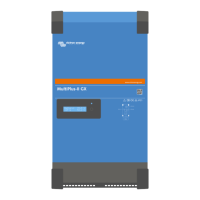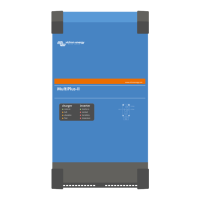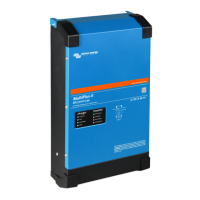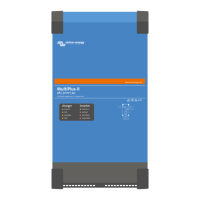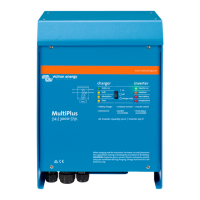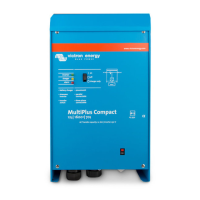WARNING
This is a safety class I product (supplied with a ground terminal for safety purposes). Its AC input and/or
output terminals and/or grounding point on the inside of the product must be provided with an unin-
terruptible grounding point for safety purposes. see Appendix A.
In a fixed installation, an uninterruptible grounding can be secured by means of the grounding wire of the AC
input. Otherwise the casing must be grounded.
This product is provided with a ground relay (relay H, see Appendix B) that automatically connects the
Neutral output to the chassis if no external AC supply is available. If an external AC supply is provided,
the ground relay H will open before the input safety relay closes. This ensures the correct operation of an
earth leakage circuit breaker that is connected to the output.
In a mobile installation (for example, with a shore current plug), interrupting the shore connection will simulta-
neously disconnect the grounding connection. In that case, the casing must be connected to the chassis (of
the vehicle) or to the hull or grounding plate (of the boat). In case of a boat, direct connection to the shore
ground is not recommended because of potential galvanic corrosion. The solution to this is using an isolation
transformer. Torque: 2 Nm
The terminal blocks can be found on the printed circuit board, see Appendix A.
Do not invert neutral and phase when connecting the AC.
The inverter does incorporate a mains frequency isolating transformer. This precludes the possibility of DC current at any AC port.
Therefore type A RCD’s can be used.
• AC-in The AC input cable can be connected to the terminal block 'AC–in'. From left to right: "N" (neutral), "PE" (earth) and "L"
(phase) The AC input must be protected by a fuse or magnetic circuit breaker rated at 32A or less, and cable cross-
section must be sized accordingly. If the input AC supply is rated at a lower value, the fuse or magnetic circuit breaker
should be down sized accordingly.
• AC-out-1 The AC output cable can be connected directly to the terminal block 'AC-out'. From left to right: "N" (neutral), "PE"
(earth) and "L" (phase) With its PowerAssist feature the Multi can add up to 3kVA (that is 3000 / 230 = 13A) to the output during
periods of peak power requirement. Together with a maximum input current of 32A this means that the output can supply up to
32 + 13 = 45 A. An earth leakage circuit breaker and a fuse or circuit breaker rated to support the expected load must be inclu-
ded in series with the output, and cable cross-section must be sized accordingly.
• AC-out-2 A second output is available that disconnects its load in the event of battery operation. On these terminals, equip-
ment is connected that may only operate if AC voltage is available on AC-in-1, e.g. an electric boiler or an air conditioner. The
load on AC-out-2 is disconnected immediately when the inverter/charger switches to battery operation. After AC power be-
comes available on AC-in-1, the load on AC-out-2 will be reconnected with a delay of approximately 2 minutes. This to allow a
genset to stabilise
9.5. Optional Connections
A number of optional connections are possible:
9.5.1. Remote Control
The product can be remotely controlled in two ways.
• With an external switch (connection terminal M, see Appendix A). Operates only if the switch on the device is set to "on".
• With a Digital Multi Control panel (connected to one of the two RJ45 sockets L, see Appendix A). Operates only if the switch on
the device is set to "on"
The Digital Multi Control panel has a rotary knob with which the maximum current of the AC input can be set: see PowerControl
and PowerAssist.
9.5.2. Programmable relay
The product is equipped with a programmable relay. The relay can be programmed for different applications, for example as
a starter relay for a generator.
9.5.3. Programmable analog/digital input/output ports
The product is equipped with 2 analog/digital input/output ports.
These ports can be used for several purposes. One application is communication with the BMS of a lithium-ion battery.
9.5.4. Voltage sense (connection terminal J, see Appendix A)
For compensating possible cable losses during charging, two sense wires can be connected with which the voltage directly on the
battery or on the positive and negative distribution points can be measured. Use wire with a cross-section of 0,75mm².
MultiPlus-II GX
16

